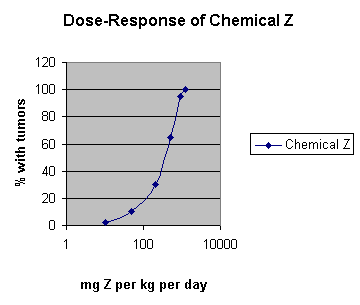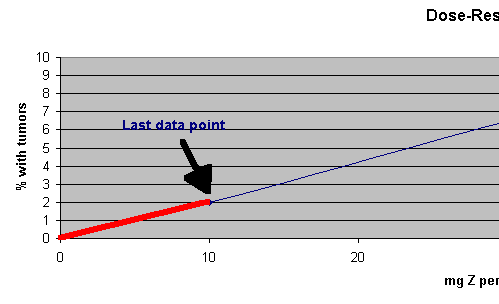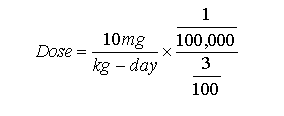
Here is the result of an animal study of the carcinogenic chemical Z. This study used 1400 rats and fed them Z each day for two years, then killed the animals and examined them for tumors. The study used 100 males and 100 female rats at each of six doses plus an unexposed control group. The study cost $1,400,000.

At the lowest dose tested, 10 mg / kg day, the study found 2% of the rats had tumors - 3 males and one female. If you are doing a risk assessment in anticipation of using chemical Z in toothpaste, what sort of risk would you be comfortable with? 1 tumor in 10,000 or 1 in 100,000? If we knew the dose of Z that produced tumors in one of 100,000 rats, we could work backwards and estimate how much Z can safely be put in toothpaste. How many rats would you need? I'd guess about 800,000 . That would be 100,000 males and that many females in each of four groups. With some economy of scale, you might treat them for $500 each, that would be only $400,000,000.
Besides the obvious practical problem, there are several theoretical problems. As you move to lower and lower doses, the curve flattens out and large changes in dose result in small changes in effect. Lower doses are inherently more difficult to measure and analyze. This problem was long ago noted and except for a few very expensive tests to explore some low dose theory, no one tries to analyze in this very low dose range. The EPA and others have instead relied on extrapolations, from high to low dose. Here is the lower end of the chemical Z test:

We just stretch a straight line from the lowest data point we have, 2% at 10 mg/kg-day, to 0% at 0 dose. (We converted from a log to a arithmetical axis.) From here it is easy to compute the dose that could cause a tumor in 1 out of 100,000 male rats. It would be :
 which works out to 0.0033 mg/kg-day, which is
the slope of the line for male rats.
which works out to 0.0033 mg/kg-day, which is
the slope of the line for male rats.
If we wanted the dose that would cause a tumor in one out of a million, it is just 0.00033 gm/kg-day. We can calculate any risk we want. This is cheap, saves rats, and is otherwise very practical. But note several things. It is based on the "no threshold theory." A chemical could reach zero effect at some much larger dose, but we are assuming it does not. Once a chemical is known to cause cancer at some high dose, it is always possible to calculate a carcinogenic effect, no mater how small the dose.
When we have our lesson on statistics, we will learn that a slightly more complicated model is used to extrapolate, but the result is the same, we compute a slope of a line. This slope factor was given the ingenious name "slope factor."
In this chemical Z example there was a difference between male and female rats. Gender differences in toxicity are common. Would we now compute the risk for male and female humans differently? As with the RfD, you need to examine the toxicology to understand where it came from. Typically the most sensitive species or gender is used in the evaluation, unless enough mechanistic data is available in order to make distinctions.